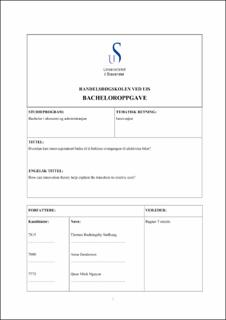| dc.contributor.advisor | Tveterås, Ragnar | |
| dc.contributor.author | Stølhaug, Thomas | |
| dc.contributor.author | Gundersen, Anna | |
| dc.contributor.author | Nguyen, Quan | |
| dc.date.accessioned | 2021-09-03T16:30:15Z | |
| dc.date.available | 2021-09-03T16:30:15Z | |
| dc.date.issued | 2021 | |
| dc.identifier | no.uis:inspera:80527366:22100429 | |
| dc.identifier.uri | https://hdl.handle.net/11250/2773212 | |
| dc.description.abstract | Vi har utført en litteraturstudie med ønske om å undersøke den aktuelle overgangen fra fossildrevne til elektriske biler. For å undersøke dette har vi benyttet innovasjonsteorier for å besvare følgende problemstilling: Hvordan kan innovasjonsteori bidra til å forklare overgangen til elektriske biler? Innovasjonsteoriene inkluderer kategoriseringen av innovasjoner, Technology Adoption Life Cycle (TALC), teknologienes s-kurve og Wrights lov. Med utgangspunkt i problemstillingen, lagde vi fire forskningsspørsmål og benyttet teoriene for å systematisk undersøke disse.
Innovasjonsteoriene hadde vanskeligheter med å tilby konkrete årsaker bak overgangen til elektriske biler. Undersøkelsen resulterte likevel i flere interessante forslag på alternative forklaringer.
Diskusjonen argumenterer for at innovasjonskategoriseringen av elbiler avhenger av hvilket perspektiv som benyttes. Videre, ble det argumentert for en potensiell sammenheng mellom hvor elbiler befinner seg i sin teknologiske utvikling, og hvor stor del av personbilmarkedet elbiler har klart å overbevise. Hvis elbilen deles inn i alle underliggende teknologier, kan det også være at timingen av flere parallelle teknologiutviklinger, sammen, kunne danne et design godkjent av en større del av markedet. Det ble også belyst en mulig sammenheng mellom prisutviklingen og produksjonsvolumet til Litium-Ion batteriteknologien og prisutviklingen til elbiler generelt. Mye tyder på at det eksisterer en sammenheng mellom disse utviklingene og overgangen til elektriske biler, men som med flere av oppgavens slutninger, trengs det mer tid og forskning til for å kunne foreslå noe konkret. | |
| dc.description.abstract | Abstract
We have performed a literature study with the mission to analyse the current transition from fossil-fueled to electric cars. To investigate this, we have used innovation theories to answer the following main question: How can innovation theory help explain the transition to electric cars? The innovation theories we have included are: Categorization of innovations, Technology Adoption Life Cycle (TALC), the technology s-curve and Wright´s law. Based on our main question, we developed four research questions and we used the theories to systematically examine these.
The innovation theories had difficulties in offering exact reasons behind the transition to electric cars. However, the research resulted in several interesting connections and alternative explanations.
The discussion argues that the innovation-categorization of electric cars depends on which perspective that´s applied. Furthermore, we argued a potential connection between how far the electric cars were in their technological development, and how large share the electric car had in the passenger car market. If we choose to divide the electric car into all its underlying technologies, we could propose that the timing of all these parallel techological developments that, combined, could form a design that got approved by a larger part of the market. Another aspect is the possible connection between price development and the production volume of lithium-ion battery technology, and the price development of electric cars in general. There are several conclusions that implies that there is a connection between these developments and the transition to electric cars, but to be able to suggest something concrete one would need more time and research on the subject. | |
| dc.language | nob | |
| dc.publisher | uis | |
| dc.title | Hvordan kan innovasjonsteori bidra til å forklare til overgangen til elektriske biler? | |
| dc.type | Bachelor thesis | |
